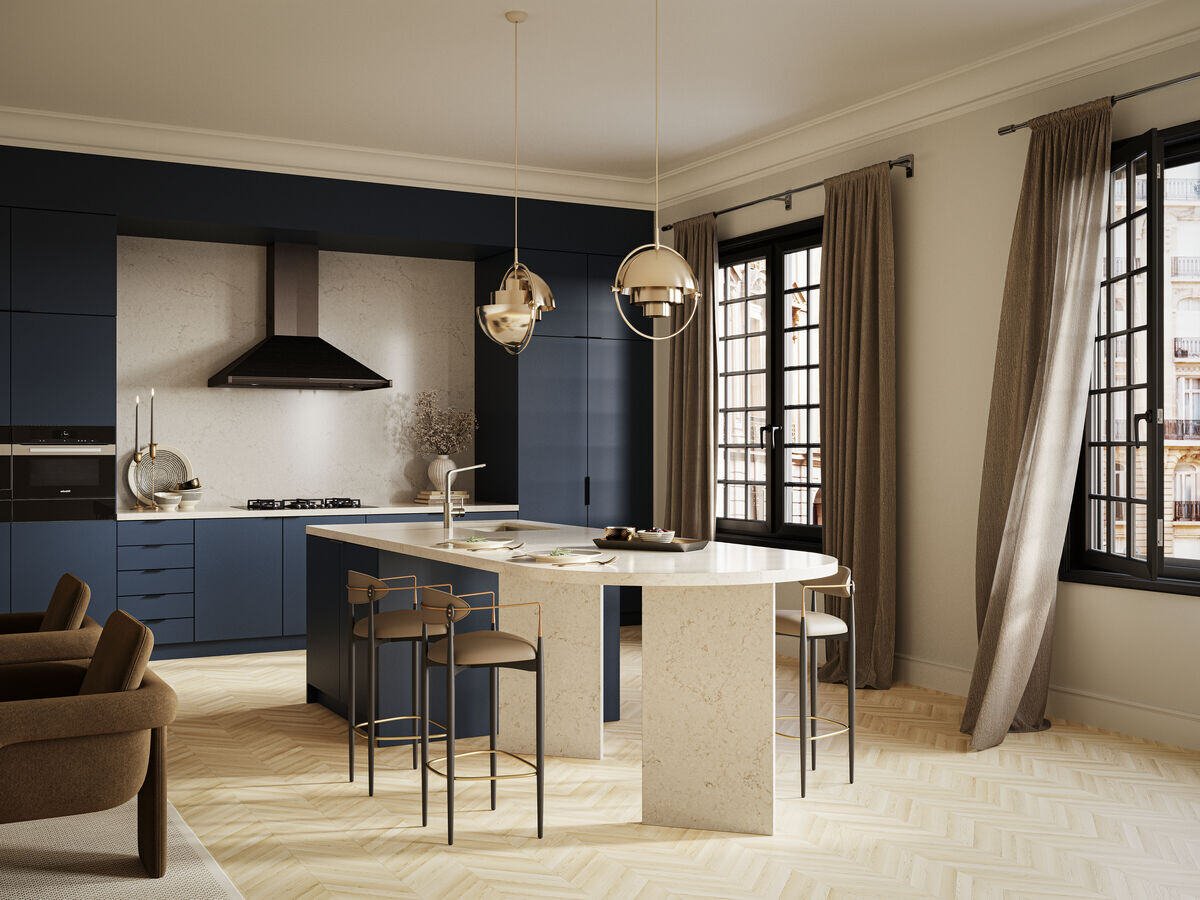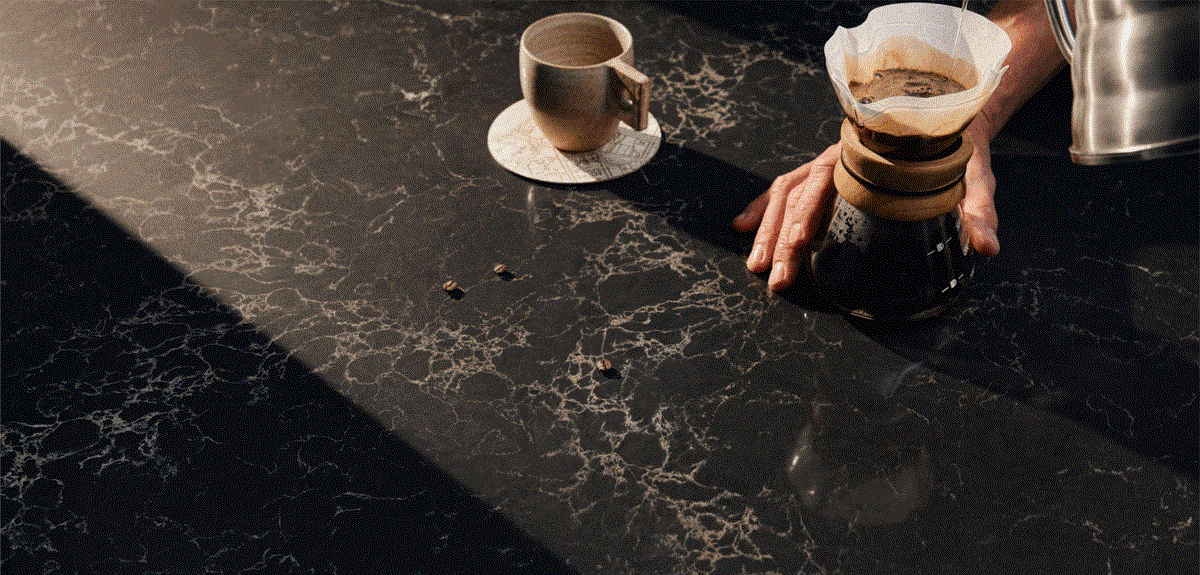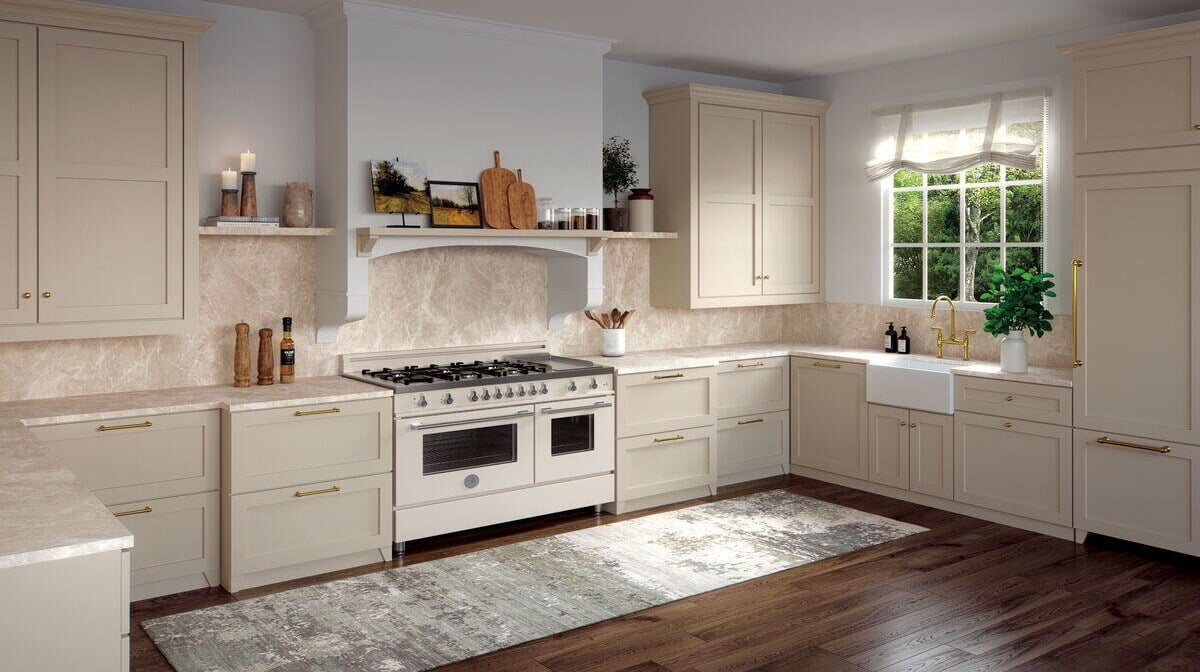
Selecting the right kitchen worktop is one of the biggest decisions you’ll make when designing or renovating your kitchen. The worktop is more than just a functional surface; it’s a major part of the foundation for your kitchen’s overall style and it takes the brunt of the daily wear and tear.
With so many materials, colours and finishes to choose from, the process can feel overwhelming. This guide will walk you through the key elements to consider, helping you balance aesthetics, functionality and personal preference to create a kitchen that is both stylish and practical.
Understanding worktop materials
The material you choose for your kitchen worktop has a massive impact on its appearance and durability, as well as what it takes to maintain it. Each material comes with its own set of advantages and challenges, so matching your selection to your lifestyle and needs is important.
Quartz worktops are a leading choice for their blend of beauty, durability and practicality. Engineered from natural quartz crystals combined with resins and pigments, these surfaces are non-porous, highly resistant to stains, scratches and bacteria, and they require minimal maintenance. Quartz is available in a huge range of colours and patterns, from marble-inspired veining to bold modern hues, ensuring there’s a style to complement any kitchen. Its consistent finish offers a polished, seamless appearance, making it ideal for contemporary and traditional designs alike.
Porcelain worktops are a rising star in modern kitchens, valued for their sleek aesthetic and impressive durability. Non-porous and made from natural clays and minerals that are kiln-fired at high temperatures, porcelain is exceptionally hardwearing, resistant to scratches, stains and heat; it also withstands UV exposure, making it suitable for outdoor kitchens. Porcelain surfaces can have the look of marble, concrete or metal, and their slim profile creates a modern, minimalist look. Porcelain’s resilience and low maintenance make it an excellent choice for design-focused, high-performance kitchens.
Mineral worktops combine natural minerals with resins and pigments to deliver unmatched durability and aesthetic flexibility. These surfaces are also non-porous, making them resistant to stains, moisture and bacteria, which is especially important for maintaining hygiene in a busy kitchen. Mineral worktops are available in a wide range of colours, patterns and finishes, from classic neutrals to bold designs, ensuring they suit every style. Unlike natural stone, their engineered nature provides consistent patterning and a flawless finish, making them a top choice for anyone seeking a balance of practicality and elegance.
Granite is a timeless natural stone and its unique veining and organic patterns make every slab one of a kind. Granite is very durable, resistant to heat and scratches and can last for decades with proper care but, as a porous material, it requires regular sealing to protect against stains and moisture. Its natural beauty and durability make it a popular choice, but it may not suit those seeking a low-maintenance option.
Laminate worktops are an affordable and versatile option, offering a wide range of colours and patterns that mimic materials like wood or stone. Made from layers of compressed paper and resin topped with a decorative surface, laminate is lightweight, easy to install and budget-friendly. However, it’s far less durable than stone or engineered surfaces, being much more susceptible to heat, scratches and moisture damage.
Wood worktops bring warmth and natural charm to kitchens, creating a cosy, inviting atmosphere, and materials like oak, walnut and beech are popular for their rich grain and character. However, they require regular maintenance including oiling, to protect against stains, water damage and wear. Wood is softer than other worktop materials, meaning it can scratch more easily, but for those willing to invest the time in care, it offers a timeless organic appeal.
When choosing a worktop material, it’s important to consider your lifestyle, design preferences and budget – and whichever material you use for your worktop, it’s recommended to use trivets for hot cookware to avoid damage.
Selecting the right colour and finish
The colour and finish of your worktop will define the overall look and feel of your kitchen. Neutral shades such as white, beige and grey are timeless and versatile. These colours also provide a clean, understated backdrop that allows other elements in your kitchen to shine. For those who prefer a bolder statement, rich, dramatic colours such as black or emerald green can add sophistication and flair, particularly in contemporary or minimalist spaces.
Natural patterns, such as those inspired by marble or granite, introduce depth and texture, making them a perfect choice for both traditional and modern kitchens. The finish of your worktop is equally important: a matte finish provides a soft, understated elegance, while a glossy finish reflects light, making smaller kitchens appear bigger and brighter.
To make sure the chosen colour and finish work with the rest of your kitchen, it helps to order worktop samples. This lets you see how the material looks in situ, particularly with your kitchen’s specific lighting conditions and how it works with (or doesn’t!) your cabinetry and flooring.
Practical considerations
While the aesthetic appeal of a worktop is an important part of the design, practical factors should never be overlooked. Your kitchen worktop must withstand the demands of everyday use, so consider qualities like heat and scratch resistance, and how easy it is to clean. Materials such as quartz, mineral and porcelain excel here, offering durability without compromising on style. Wood on the other hand may be visually striking, but it also requires more careful cleaning.
Maintenance is another critical factor to keep in mind. Some materials, like marble and granite, require regular sealing and special cleaning products to maintain their appearance. Others, like porcelain, quartz and mineral, are more forgiving and easier to maintain, which is particularly beneficial for busy households. Budget is also a key consideration. High-end materials like quartz, marble and granite may come with a higher price tag, but many see them as long-term investments. On the other hand, laminate is more suited to those with a tighter budget.
Another thing to keep in mind is that similar worktops (i.e. made of the same material) won’t necessarily be the same quality – for example, a porcelain worktop from one manufacturer won’t be the same as a porcelain worktop from a different one. Because of this, you should always look out for reputable brands with proven track records of delivering quality worktops, such as Caesarstone.
It’s also worth asking about warranties when choosing a worktop; a good warranty can offer peace of mind, ensuring your investment is protected for years to come.
Personalising your kitchen worktop
Your kitchen worktop is not just a functional element; it’s an opportunity to express your personal style and enhance the overall design of your space. To create a striking visual contrast, pair dark worktops with light cabinetry or vice versa. For a sleek and contemporary look, consider incorporating design features such as waterfall edges, where the worktop extends down the sides of the cabinets for a seamless appearance.
Final thoughts
Choosing the perfect kitchen worktop involves balancing style, functionality and your personal preferences. With so many options available, from durable quartz surfaces to the timeless elegance of mineral and the stunning beauty of porcelain, there’s a solution for every kitchen. At Caesarstone, we offer an extensive range of premium worktops designed to inspire and elevate your kitchen design.
Get inspired, explore our collection or order a sample today to begin your journey toward the kitchen of your dreams.







.jpg)